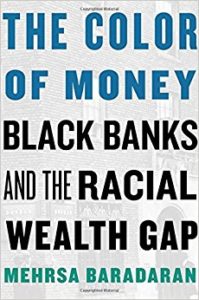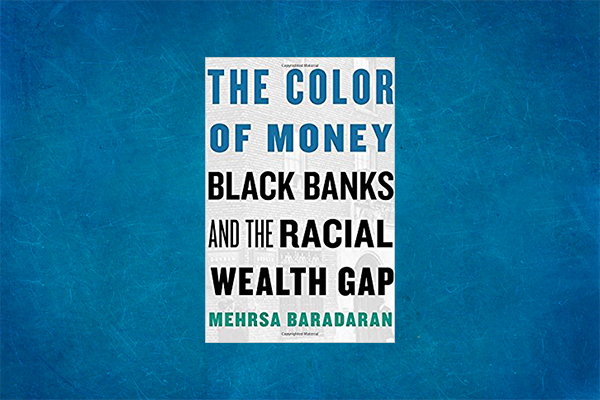 I think of myself as pretty informed about financial history in the United States, but Mehrsa Baradaran’s The Color of Money: Black Banks and the Racial Wealth Gap covers a whole area of history about which I knew very little.
I think of myself as pretty informed about financial history in the United States, but Mehrsa Baradaran’s The Color of Money: Black Banks and the Racial Wealth Gap covers a whole area of history about which I knew very little.
In a narrow sense Baradaran’s book is about the history of black-owned and black-customer-oriented banks. It’s a history without a lot of happy success stories. The story of the Freedman’s Bank, established in 1865 with Lincoln’s signature and a Congressional mandate to help build assets among the newly freed slaves in the South, ends in catastrophe when the (white) managers engage in a combination of speculation and fraud. Decades before the establishment of the FDIC, the bank failure caused direct financial losses to its black customers and a total loss of trust in the traditional banking system.
Of that experience, W.E.B. Dubois would say
“Not even ten additional years of slavery could have done so much to throttle the thrift of the freedmen as the mismanagement and bankruptcy of the series of savings banks chartered by the Nation for their special aid.”
Black Capitalism
In a broader sense, Baradaran’s story is a lesson in the complicated story of “black capitalism” and the 150-year debate within and without the African-American community about separatism versus integration for gaining political and economic power with respect to the majority culture. Beginning just after Emancipation and until the present day, leaders of the black community have urged strength through channeling the “black dollar,” whether through patronizing black-owned businesses or depositing money in black-owned banks. The success or failure of this approach can’t be determined definitely, although Baradaran provides numerous examples of the start-and-stop nature of the efforts. There aren’t a lot of consistent examples where it has worked well.
In fact, a central thesis of Baradaran’s book is that black banks not only cannot thrive outside of the majority culture – collecting black deposits and funneling capital back into the white system – but that they remain inherently weakened by the separation. Serving a depositor community with higher rates of poverty, while lending to a community with depressed housing values, has been a recipe for undercapitalized, unprofitable banks, at least historically. As she documents, the market forces that might outweigh these weaknesses – such as charging higher rates of interest on loans or offering lower rates on deposits haven’t worked either, and they open up the banks to charges of predatory practices.
The black banks might be the victims of (or left weaker by) the larger system, but are often perceived as part of a power structure that’s “disloyal” to the black community. And that’s when they do normal things that banks do.
One of the most interesting sections is Baradaran’s focus on the uses that the Nixon administration – and the federal government before and after Nixon – makes of the idea of “black capitalism.” In Baradaran’s telling, and there’s plenty of evidence in the book of this, Nixon sought to co-opt, blunt, or redirect Black Power through programs that seemed to celebrate and support “Black Capitalism.” But “Black Capitalism” programs historically function as a decoy for the black community and an appeal to the white community, rather than representing something fundamental or substantive.
The “capitalism is the answer” approach of Nixon was then recreated and expanded by Clinton and Obama, and Baradaran remains deeply skeptical of their efficacy as well.
The Southern Strategy
On the even more cynical side of political strategies, Baradaran directs the reader to an (in)famous interview by Republican strategist Lee Atwater, in 1982, about the “Southern Strategy.” I hadn’t heard of the interview before, and happened to locate it on Youtube recently, on the same day as the Senate vote on tax reform. I feel like this is an interview everybody should know about, in which Atwater sort of gives away the whole game, saying:
There’s a part of all contemporary politics wrapped in a nutshell in this recording, so I’m sort of shocked I’d never been directed to this before. But…that’s why we read a history like Baradaran’s about a subject on which we know very little. You should listen to Atwater in the YouTube clip but here’s the gist:
“You start out in 1954 saying Nig–, Nig–, Nig–. By 1968 you can’t say Nig__, that hurts you, backfires. So you say stuff like, uh, forced busing, states’ rights, and all that stuff, and you’re getting so abstract. Now, you’re talking about cutting taxes, and all these things you’re talking about are totally economic things and a byproduct of them is, blacks get hurt more than whites.”
The overlap of listening to Atwater, and the “Tax Reform” rush by the Senate in November 2017 suggested to me that little has changed since 1982.
Capitalism itself
In the broadest sense, The Color of Money spoke to me as a fundamental critique of capitalism itself, via a funny coincidence in my own life. I happened to be reading the book while a teacher friend invited me to lecture to high school senior AP students on a passage from Adam Smith’s The Wealth of Nations. Of course I felt the need to explain to the students the foundational nature of the text – Smith basically kicked off the invention of Classical Economics.
And yet, reading the passage in the light of the history of black capitalism, Smith’s words sound absurd.
In Chapter 10 of The Wealth of Nations, titled “Of Wages and Profit in the Different Employments of Labor and Stock,” Smith writes:
“The whole of the advantages and disadvantages of the different employments of labour and stock must, in the same neighborhood, be either perfectly equal or continually tending to equality….”
Ok, so here we have a classical economics trope on equilibrium between capital and labor, which has certainly not yet come true. BUT! Smith brings in his conditions, in the next paragraph, for how equilibrium and equality will occur:
“This at least would be the case in a society where things were left to follow their natural course, where there was perfect liberty, and where every man was perfectly free both to chuse what occupation he thought proper, and to change it as often as he though proper.”
Ok, so this passage was published in 1776 – a time of an active slave trade and even slave-like working conditions in Smith’s home country of Scotland.
The “perfect liberty” he describes was not true then, and it hasn’t been true yet in the last 150 years. So as I was teaching this passage to the high schoolers, and thinking over Baradaran’s book, the absurdity of classical economics based on this “perfect liberty” just seemed a perfect/imperfect point/counterpoint.
I’m a capitalist, and I’m not willing to give up on the system yet. But Baradaran’s book is just one reminder of the absurdity of some of Adam Smith’s foundational statements about capitalism. There’s nothing inevitable about equality or equilibrium at all. Smith passage just seems absurd. The market actually requires laws and justice and redress, in order to let the market do its thing, effectively.
Please see related posts:
Book Review: Nickel and Dimed by Barbara Ehrenreich
Book Review: The Price Of Inequality by Joseph Stiglitz
Book Review: Plutocrats: The Rise Of The New Global Super-Rich by Chrystia Freelander
All Bankers Anonymous Book Reviews in one place!
Post read (1676) times.







